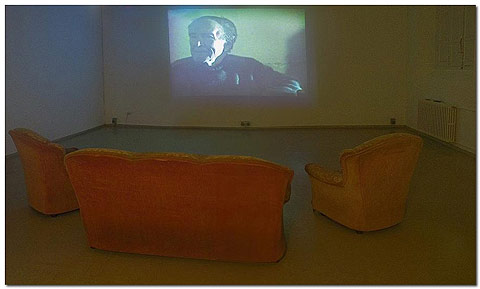Pontevedra Art Biennial,
Jul 13, 2006 - Sep 03, 2006
Pontevedra, Spain
29th Pontevedra Art Biennial. Flight from an imagined scenario
by David Barro
Above all, however, this Biennial seeks to capture a virtual and imagined threshold that seems more diffuse than ever. This is the idea behind Din Matamoros’ painting, which is expressed as a flash capable of diluting everything, of diminishing the figure through a fragmentary light that definitively stores any image in one’s retina. It thus shifts the mental movie of each spectator, who, on flirting with that abyss in the form of an exaggerated expression of light, will understand that basically Matamoros’ intentions are none other than to condense life in a frame while blurring each contour; moving in that precise instant where time folds, as in the white geographies projected by Marco Maggi. That hinge-shaped time makes us lose our bearings, playing with a lack of place, with that unfathomable mental mystery. Ricardo Lanzarinis’drawings on tobacco-rolling paper could act as timid metaphors of that fragile journey, of this imagined universe that can freeze a time that will never be as real as we would want it to be.
This particular Pontevedra Biennial features works such as Marina De Caro’s, who hand embroiders an imagined paradise that can envelop the spectator; Eduardo Basualdo, who tells us a story through an installation-performance that projects the exiled shadows of a phantasmagorical scale model; or Diego Santomé, who reflects on the banality of a journey on a cruise ship. All this is based on an imaginary border that can lead to an absolute impossibility, something expressed by a Carlos Rial who has accustomed us to something more specific, but that here he resolves by imagining, in line with the whole aim of the Biennial.
In the final analysis, everything takes shape by affirming the differences involved in the affirmation of freedom: freedom of thought and of imagination, freedom of opinion and of action from the place itself; premises that the commissioner has viewed as vital in defining its discourse. In its text it therefore views the status of each work as a presence and agent rather than as an interpretation: "In this Biennial, the questions that are explored are: How is this work constructed in terms of its poetry and its locality? And, furthermore, what does this work desire or want? And what does it say about ourselves," as the commissioner states in the catalogue.
Quite a melancholic battle, like the look on the artist Ana Gallardo’s uncle, who left Granada 52 years ago, never to return - the experience of the landscapes recorded by the artist and reflected in her uncle Eduardo’s fixed gaze tells us that we always leave many things behind on a journey; likewise, the football fiction proposed here by Sebastián Gordín, the blurriness of Vari Caramés’ photographs, the metaphorical dual nationality set forth by Patricio Larrambebere, or Judi Werthein’s performance cult. Such is the web woven by this discourse on migration, more translucent than Daniel Joglar’s fluorescent web of rosaries but just as luminous for those who endure distance as a permanent darkness.
|













